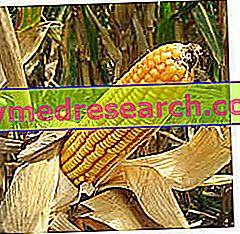Generality
Maize is a herbaceous plant belonging to the Poaceae family, Subfamily Panicoideae, Genus Zea, Species mays ; its binomial nomenclature is therefore Zea mays .
Belonging to the family of the Graminaceae (or Poaceae if you prefer), and producing seeds rich in starch, corn is fully included among cereals, just like wheat, barley, rice, rye, oats, sorghum and millet (which belong to the Graminaceae family), but also as buckwheat, quinoa and amaranth (sometimes called pseudo-cereals because they belong to different families).

Maize originates from the American continent where the first crops seem to date back to the prehistoric era.
Some terms used in common language totally overturn the correct botanical terminology; in fact, what is commonly referred to as corn cob (understood as the cob with attached edible seeds) is actually the ear ; vice versa, the so-called "plume" or spike is properly a panicle.
History
The first corn crops began to spread around 2, 500 BC in Mesoamerica (a region of the American continent that includes the southern half of Mexico, the territories of Guatemala, El Salvador and Belize, the western part of Honduras, Nicaragua and Costa Rica ).
The peoples who used corn cultivation (Olmechi and Maya) were already able to process the cereal in order to improve its nutritional content; in particular, through the nixtamalization process (cooking of corn with lime - calcium hydroxide), the natives compensated for the lack of bioavailable niacin (vit. PP or B3), avoiding the onset of the famous pellagra (a nutritional deficiency disease of the same ). In fact, in the natural seed of maize, niacin is present in a form NOT usable by the human organism.
Following the first contacts with the European peoples (XV-XVI century AD), maize reached the Old Continent and subsequently also Africa and Asia.
The first major differentiation between the various types of maize is that between seeds for human consumption and those for animal feed or chemical processing. In America, maize is the most widespread crop; annual productivity is 332, 000, 000 tons, of which 40% of the total is destined for the production of bio-gas (ethanol). Maize is also one of the plants most subjected to genetic modifications.
Etymology of the term "maize"
The word maize derives from the Spanish form of the noun coined by the Taino population: " maiz ", which later became " maize" .

Description
The cultivated maize plant reaches an average height of 2.5m, while some wild varieties can reach 12m.
The stem (more correctly stem ), also known as stocco, is similar to a bamboo cane segmented by about 20 internodes. From each node starts a leaf about 70-120cm long and up to 8 / 9cm wide.
Maize is a monoecious plant that means it has male and female flowers carried on the same plant but on two separate inflorescences (diclini flowers).

- The female inflorescences are the ears, constituted by a fibrous stalk bound to the stem, covered with leaves. The seeds (up to 600) are attached to the cob (mistakenly called panicle); inside, up to the top of the ears, a brunasto tuft appears (stigma) vulgarly called "silk".
- At the apex of the plant there are the male inflorescences, or rather the panicles properly called (erroneously called spikes).
Maize reproduces itself fundamentally by anemophilia (dispersion of pollen with the wind), even if the range of action of each single plant is not very wide. The seeds are the same size as the peas, with an external caryopsis fused to the pericarp; they can be blackish, gray-blue, purple, green, red, white and yellow.
Corn grains are very rich in starch and fiber. Dried and ground give rise to a raw flour; if refined, from the corn flour it is possible to obtain the cornstarch (or corn starch). Maize does NOT contain gluten and, if on the one hand it is allowed in the celiac diet, on the other it cannot be used individually for bread making. There are varieties of corn that are richer in simple sugars that are called "sweet corn". The small ears of sweet corn (which we remember being mistakenly called panicchie) can also be eaten raw; large but still tender ones need short thermal treatments, while dry ones must undergo a very long boiling.
The corn grows and reproduces successfully at temperatures above 10 ° C; it tolerates latitudes well with very long nocturnal periods and, thanks to its content in natural defensive molecules (2, 4-dihydroxy - 7 - methoxy - 1, 4 - benzoxazin - 3-one - DIMBOA), it is particularly resistant to attack by parasites . On the other hand, maize does NOT tolerate drought and in recent years has been the subject of the worrying phenomenon of aflatoxins.
Genetics and diffuse varieties of corn
The maize plant has a great polymorphism, evident species in the weight, shape and color of the caryopsis. For this reason we have 8 groups, referred to as subspecies or sub-species, destined to many preparations: corn flour (var. Amylacea ), popcorn (var. Everta ), dent corn (var. Indentata ), flint mais (var. indurata ), sweet corn (var. saccharata and var. rugosa ), waxy maize (var. ceratina ), pod mais (var. tunicata Larranaga ex. A. St. Hil.) and maize with stripes (var. japonica ). Currently, the classification of maize has become more detailed and articulated; it includes: forms, races, racial complexes and branches.
With the selection and the re-crossing it was possible to obtain different varieties of maize, basically from increasingly larger seeds. Most of the corn grown today is of the GMO type (about 25 crops - 86% of US maize - 2010 - 32% of the world maize in 2011); this is not always considered edible for humans and in the year 2, 000, 50, 000, 000 dollars of "Taco Bell" were withdrawn from the market because they contained traces of GM maize unsuitable for human consumption.
Corn as food for humans
Corn is a primary food source for human beings. In Mexico, for example, the cereal is present in every culinary preparation; they are typical dishes: tortillas, pozole, atole and all composites such as tacos, quesadillas, chilaquiles, enchiladas, tostadas etc. In Africa, too, maize has become the most important crop in the area among cereals, while in Europe it is the basic constituent for polenta in Italy, in Brazil, in Mamaliga in Romania, etc.
Corn is also the essential raw material for producing one of the oldest snacks: pop corn. Today it is also available fried corn (with salted and crunchy grains), while through an industrial process it becomes a typical breakfast food: corn flakes.
After fermentation and distillation, maize is the Chicha and Chicha morada, a widespread alcoholic beverage in Peru.
Young or unripe corn, boiled or roasted, is consumed as a dish in its own right; sweet corn is sufficiently digestible even raw.
Corn oil, obtained from the "living" portion of the seeds, is very rich in ω-6 polyunsaturated fatty acids.
Nutritional values of corn
The corn, in its various forms, has a function mainly of first course, a single dish or accompaniment (side dish or baked goods). Like all cereals, it has a predominantly energetic nutritional function. The macronutrients contained in greater quantities are carbohydrates, mainly simple in sweet corn, and complex in other varieties. Corn flours and dry maize are foods of very high energy value, since the water content is reduced to a minimum. The preparation made from typical Italian cornmeal is polenta which, on the other hand, absorbs up to 300% of water during cooking, considerably reducing the glycemic load and overall caloric intake. Corn flakes and popcorn have a chemical content similar to that of simple corn flour, although the latter, in preparation, require the use of several greases for cooking. Corn starch corresponds to a super-purified fiber from flour, lipids and proteins.
The corn in a jar is the product that, due to its hydration, boasts the lowest energy supply compared to the others mentioned.
Maize does not contain many proteins which, based on the amino acid profile, have a medium biological value. The lipids are even more scarce, while the dietary fiber is present above all in the whole grain of the raw seed (raw corn and popcorn corn). Corn is obviously cholesterol-free.
From the saline point of view, the corn contains discrete amounts of potassium and good (considering that it is a cereal) portions of iron. As for the vitamins, the water-soluble thiamine (vit B1) and the less bioavailable niacin (vit PP) stand out. Small concentrations of retinol equivalent are noted (vit. A), while corn oil is rich in vitamin E.
Corn-based products are suitable for the consumption of celiacs, as they do not contain gluten, but it is worth remembering that good portions of these foods carry high glycemic loads, which are not recommended in the overweight diet and against type 2 diabetes mellitus.
Nutritional values
Nutritional composition for 100g of: Corn Flakes; Corn flour; Corn; Sweet corn, canned, drained; Corn starch; Pop Corn - Reference Values of Food Composition Tables - INRAN
| Corn flakes | corn flour | Corn | Sweet corn, canned, drained | Corn starch | Pop Corn | ||
| Edible part | 100.0% | 100.0% | 100.0% | 100.0% | 100.0% | 100, 0g | |
| water | 5.0g | 12.5g | 12.5.0g | 70.3g | 12.0g | 4, 3G | |
| Protein | 6.6g | 8.7g | 9.2g | 3.4g | 0.3g | 12, 0g | |
| Prevailing amino acids | - | B.C. glutamic, Leucine, Proline | B.C. glutamic, Leucine, Proline | - | - | - | |
| Limiting amino acid | - | Lysine | Lysine | - | - | - | |
| Lipids TOT | 0.8g | 2.7g | 3.8g | 1.3g | tr | 4.2g | |
| Saturated fatty acids | - g | 0.31g | 0.58g | - g | - g | - g | |
| Monounsaturated fatty acids | - g | 0.66g | 0.87g | - g | - g | - g | |
| Polyunsaturated fatty acids | - g | 1.41g | 1.67g | - g | - g | - g | |
| Cholesterol | 0.0mg | 0.0mg | 0.0mg | 0.0mg | 0.0mg | 0.0g | |
| TOT Carbohydrates | 87.4g | 80.8g | 75.1g | 19.5g | 86.8g | 77, 9g | |
| Starch | 70.0g | 72.1g | 66.0g | 13.8g | 76.7g | - | |
| Soluble sugars | 10.4mg | 1.5mg | 2.5g | 4.3g | 2.5g | - | |
| Dietary fiber | 3.8g | 3.1g | 20.g | 1.4g | 0.0g | 15, 1g | |
| Soluble | - g | 0.35g | - g | - g | - g | - g | |
| Insoluble | - g | 2.76g | - g | - g | - g | - g | |
| Power | 361.0kcal | 362.0kcal | 353.0kcal | 98.0kcal | 327.0kcal | 378, 0kcal | |
| Sodium | 11.0mg | 1.0mg | 35.0mg | 270.0mg | 0.0mg | 4, 0mg | |
| Potassium | 99.0mg | 130.0mg | 287.0mg | 220.0mg | 0.0mg | 301, 0mg | |
| Iron | 2.8mg | 1.8mg | 2.4mg | 0.5mg | - mg | 2, 7mg | |
| Football | 74.0mg | 6.0mg | 15.0mg | 4.0mg | - mg | 10, 0mg | |
| Phosphorus | 58.0mg | 99.0mg | 256.0mg | 79.0mg | - mg | 300, 0mg | |
| Thiamine | - mg | 0.35 mg | 0.36mg | 0.25mg | - mg | 0, 20mg | |
| Riboflavin | - mg | 0.10mg | 0.20mg | 0.18mg | - mg | 0, 28mg | |
| Niacin | - mg | 1.90mg | 1.50mg | 0.86mg | - mg | 1, 95mg | |
| Vitamin A | 28.0μg | 67.0μg | 62.0μg | 24.0μg | - µg | 20, 0μg | |
| C vitamin | 0.0mg | 0.0mg | 0.0mg | 7.0mg | 0.0mg | 0, 0mg | |
| Vitamin E | - mg | tr | - mg | 0.5mg | 0.0mg | - mg | |



